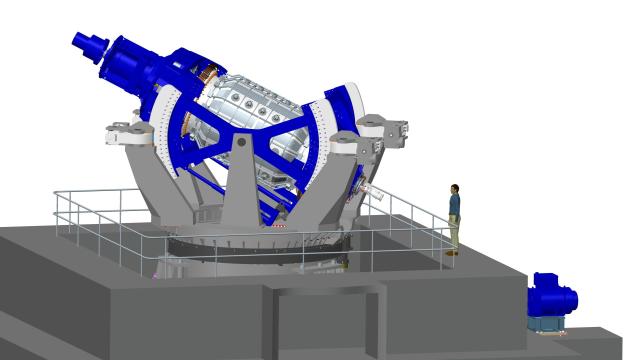Admit it, you don’t really understand why the Earth has a magnetic field. Sure, movement inside the Earth’s outer core is creating a electric current, generating a magnetic field through it. But what’s causing this movement?
In this mockup, a scientist is dwarfed by an enormous spinning cylinder. Graphic: SBS Bühnentechnik GmbH (Helmholtz-Zentrum Dresden-Rossendorf )
There’s a ton that scientists still don’t know about our planet’s magnetosphere, and about planetary magnetic fields in general. There are several effects hypothesised to add to this “dynamo” that drives the magnetic field. Some think it’s related to the buoyancy of the metals inside the Earth, for example. But these scientists want to know how precession, like the motion of a wobbling top, adds into the mix.
To try to figure it out, German scientists are recreating the whole damn Earth in a lab. Sort of.
“While it is undisputed that these fields are generated by the conversion of mechanical energy from the flow of an electrically conductive fluid, there are various possibilities to drive the underlying fluid motions,” the team of researchers from Helmholtz-Zentrum Dresden-Rossendorf in Germany wrote in a paper published recently in Physical Review Letters.
The researchers are constructing the DREsden Sodium facility for DYNamo and thermohydraulic studies, or DRESDYN. It’s an angled cylinder 2m across filled with eight tonnes of liquid sodium spinning on two axes: Ten times per second through the cylinder’s flat parts and once per second through the axis perpendicular to the floor, as demonstrated in the above mockup.
Again, it’s like a slowing spinning top, rotating in two ways at once. Except it’s eight tonnes of liquid sodium.
The idea here is that magnetic fields tend to travel perpendicularly to electric fields, so if you have a coil of electric field, the magnetic field would travel vertically through it. The scientists want to see how important the precession motion is to this field-generating dynamo effect. They have already tested it out using a one-sixth scale model filled with water. They have begun to observe some interesting rotation in the water that could potentially generate a magnetic field in a more conductive fluid, such as liquid sodium.
Others have attempted such experiments on a smaller scale, and they do observe magnetic effects. Some have included propellers inside the liquid, but this one will not. DRESDYN scientists expect to begin taking data in 2020.
